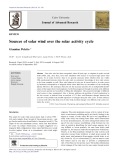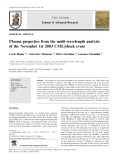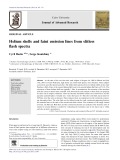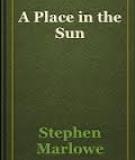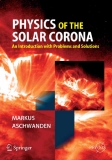
Sun corona
-
The solar wind was originally envisioned using a simple dipolar corona/polar coronal hole sources picture, but modern observations and models, together with the recent unusual solar cycle minimum, have demonstrated the limitations of this picture. The solar surface fields in both polar and low-to-mid-latitude active region zones routinely produce coronal magnetic fields and related solar wind sources much more complex than a dipole.
 8p
8p  kethamoi1
kethamoi1
 17-11-2019
17-11-2019
 29
29
 3
3
 Download
Download
-
Fast solar wind has been recognized, about 40 years ago, to originate in polar coronal holes (CHs), that, since then, have been identified with sources of recurrent high speed wind streams. As of today, however, there is no general consensus about whether there are, within CHs, preferential locations where the solar wind is accelerated. Knowledge of slow wind sources is far from complete as well. Slow wind observed in situ can be traced back to its solar source by backward extrapolation of magnetic fields whose field lines are streamlines of the outflowing plasma.
 6p
6p  kethamoi1
kethamoi1
 17-11-2019
17-11-2019
 20
20
 0
0
 Download
Download
-
The analysis of the spectral properties and dynamic evolution of a CME/shock event observed on November 1st 2003 in white-light by the LASCO coronagraph and in the ultraviolet by the UVCS instrument operating aboard SOHO, has been performed to compute the properties of some important plasma parameters in the middle corona below about 2Rx. Simultaneous observations obtained with the MLSO/Mk4 white-light coronagraph, providing both the early evolution of the CME expansion in the corona and the pre-shock electron density profile along the CME front, were also used to study this event.
 4p
4p  kethamoi1
kethamoi1
 17-11-2019
17-11-2019
 14
14
 0
0
 Download
Download
-
At the time of the two last solar total eclipses of August 1st, 2008 in Siberia and July 11th, 2010 in French Polynesia, high frame rate CCD flash spectra were obtained. These eclipses occurred in quiet Sun period and after. The slitless flash spectra show two helium shells, in the weak Paschen a 4686 A˚ line of the ionized helium HeII and in the neutral helium HeI line at 4713 A˚ . The extensions of these helium shells are typically 3 Mm. In prominences, the extension of the interface with the corona is much more extended.
 7p
7p  kethamoi1
kethamoi1
 17-11-2019
17-11-2019
 9
9
 0
0
 Download
Download
-
The SOS crackled and hummed through subspace at a speed which left laggard light far behind. Since subspace distances do not coincide with normal space distances, the SOS was first picked up by a Fomalhautian freighter bound for Capella although it had been issued from a point in normal space midway between the orbit of Mercury and the sun's corona in the solar system.
 26p
26p  hotmoingay9
hotmoingay9
 26-01-2013
26-01-2013
 53
53
 2
2
 Download
Download
-
In this book we provide a comprehensive introduction into the basic physics of phenomena in the solar corona. Solar physics has evolved over three distinctly different phases using progressively more sophisticated observing tools. The first phase of naked-eye observations that dates back over several thousands of years has been mainly concerned with observations and reports of solar eclipses and the role of the Sun in celestial mechanics.
 0p
0p  tom_123
tom_123
 14-11-2012
14-11-2012
 56
56
 4
4
 Download
Download
CHỦ ĐỀ BẠN MUỐN TÌM









